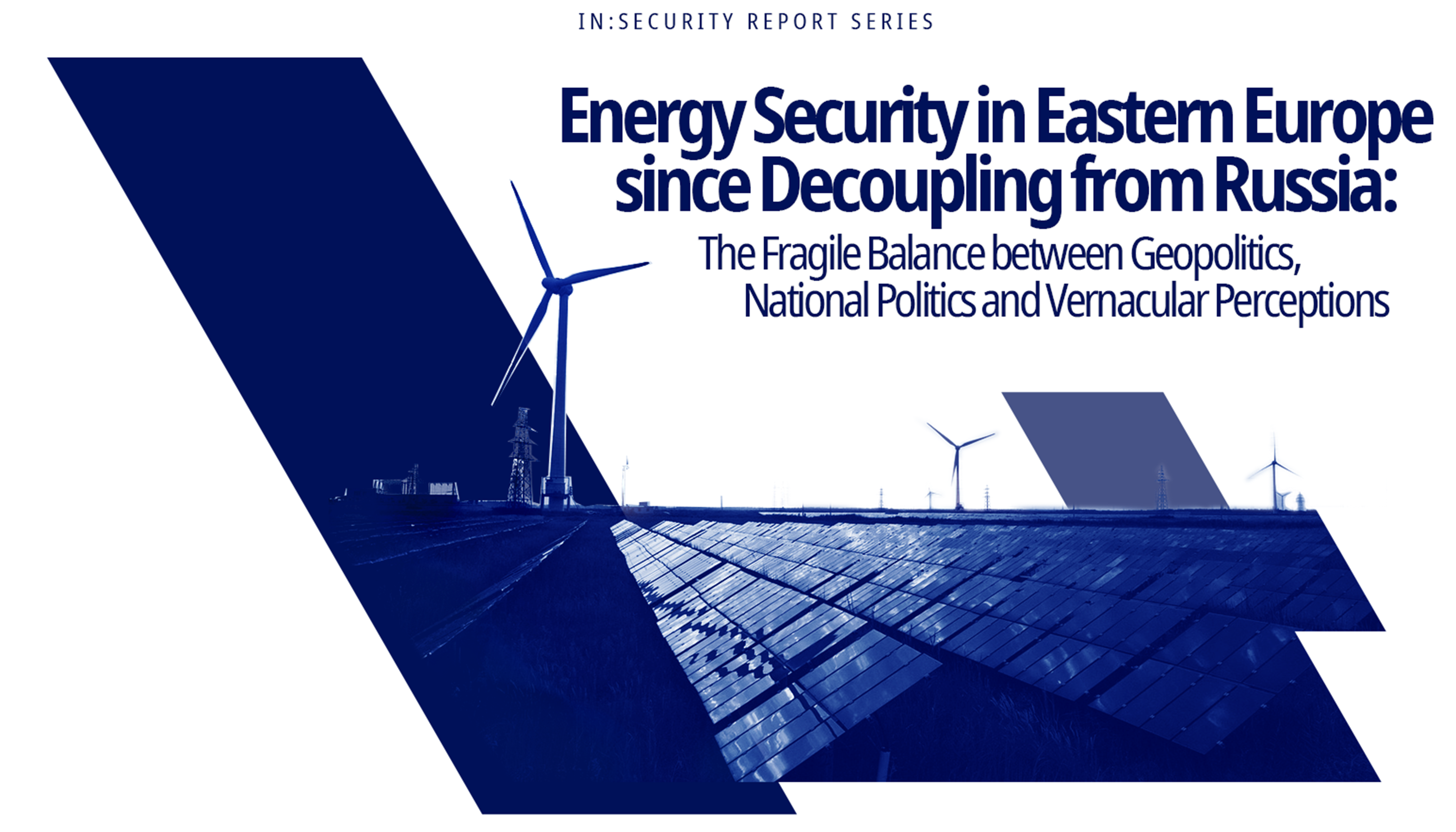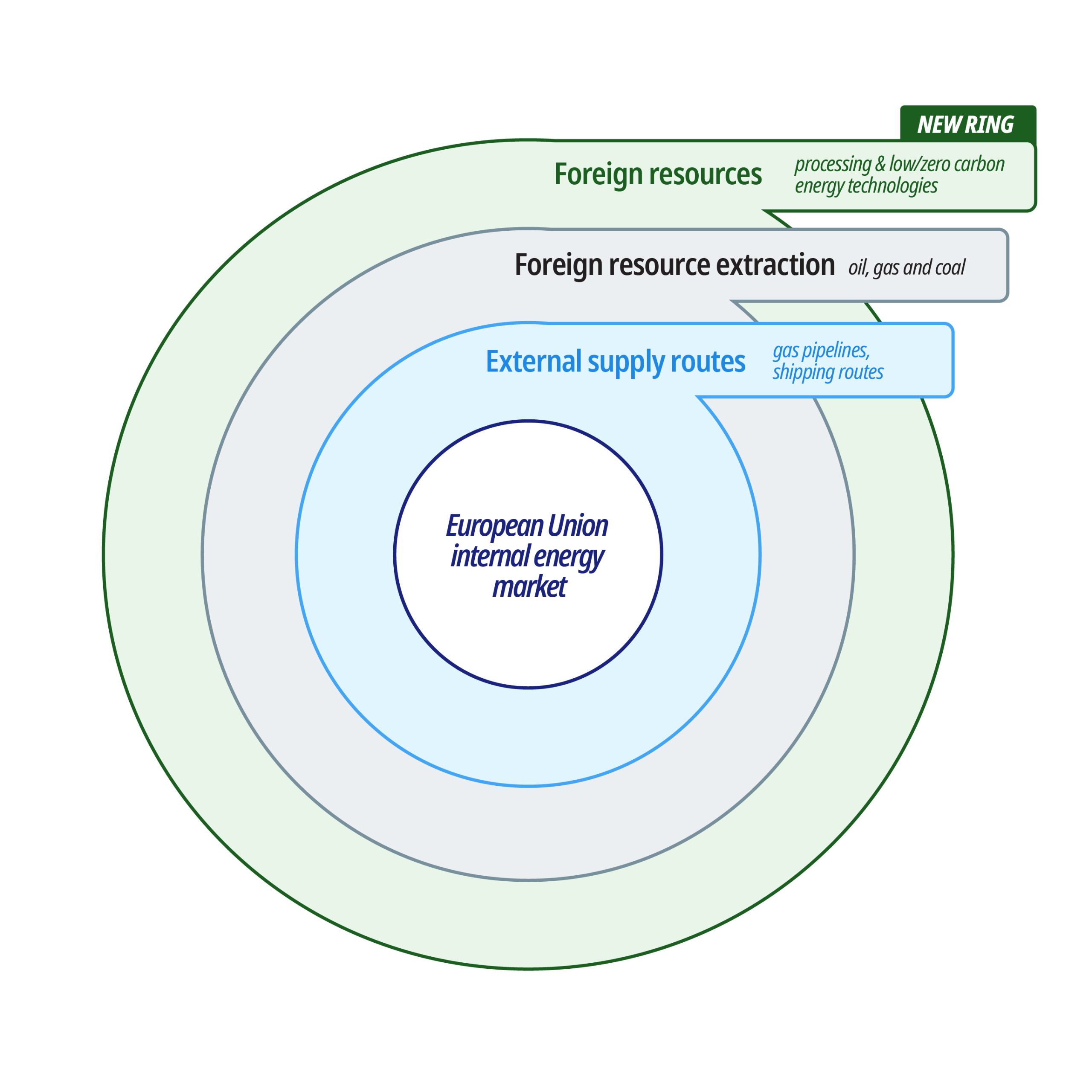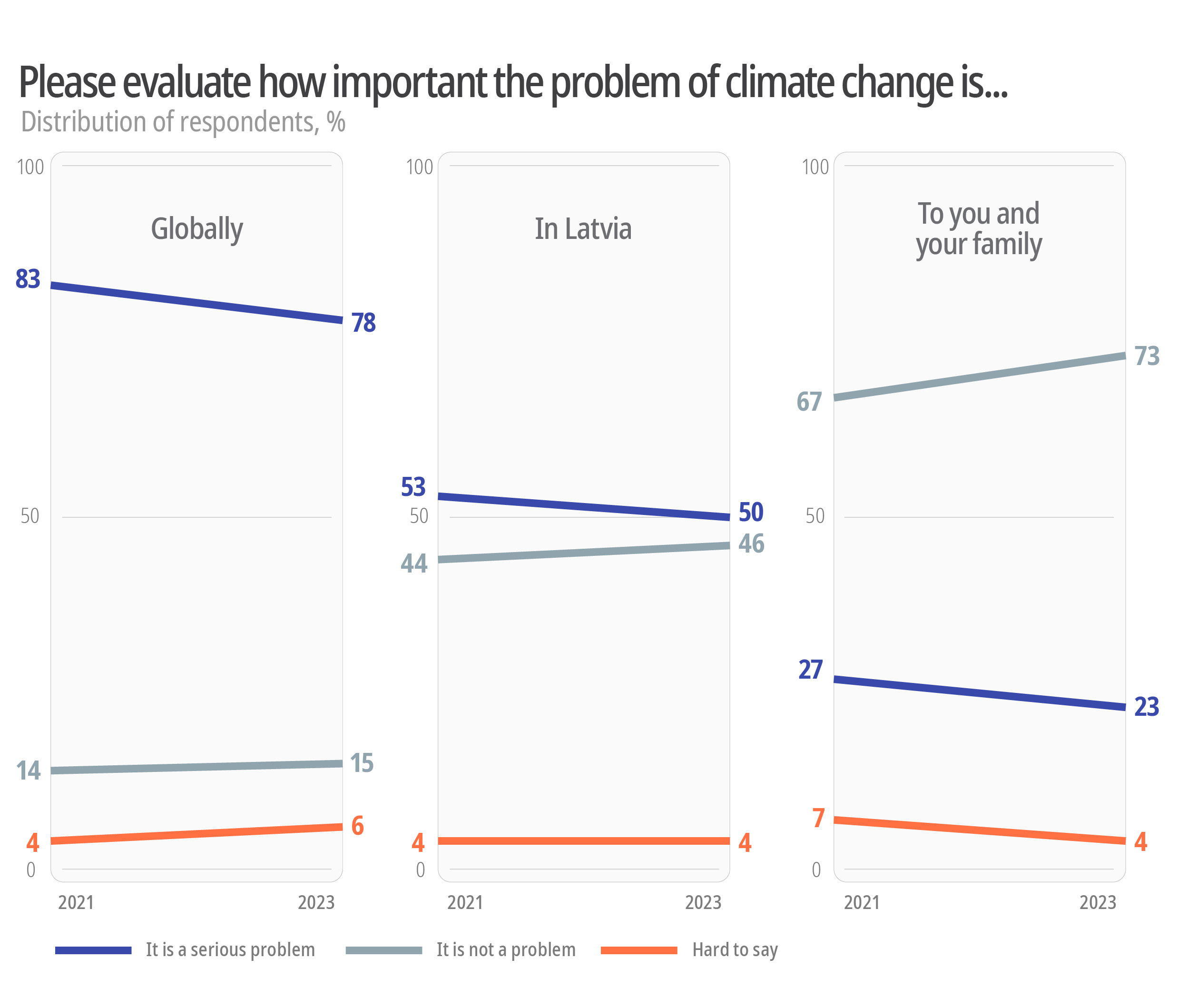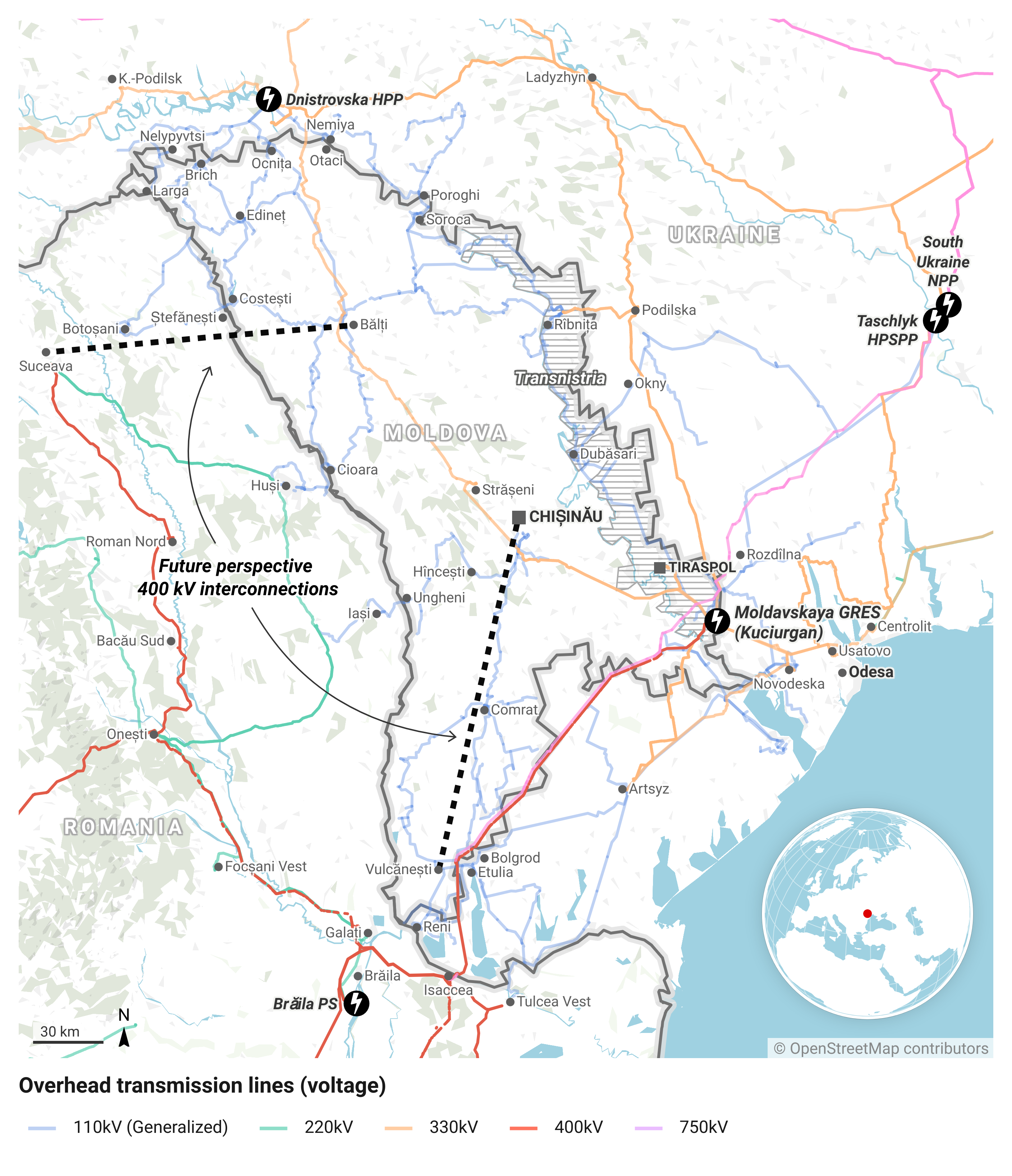
Citation: Nadja Douglas, Sophie Lambroschini, Michael LaBelle, Vineta Kleinberga, Ana Otilia Nuțu, Andrian Prokip, Energy Security in Eastern Europe since Decoupling from Russia: The Fragile Balance between Geopolitics, National Politics and Vernacular Perceptions, KonKoop In:Security Report 2/2024
Image: Solar cell panels in the foreground, wind turbines in the middle ground, and electricity pylons in the background; unidentified location, 2016 (c) Kenueone, pixabay, Creative Commons Zero
Acknowledgment: The editors cordially thank Dr. Benjamin Beuerle for his involvement in the expert workshop and subsequent review and constructive comments to the manuscript.
Russia’s war against Ukraine demonstrated how vulnerable states are with regard to their energy supply.
Already prior to the Russian invasion, renewable energy had been the fastest growing source of energy.
[6] de Micco, 10 April.2014.
[7] Falkner, 8 September 2023.
[8] Bubandt 2005.
[9] Compare Cherp/Jewell 2014: 415–421. The concept was originally introduced by the Asia-Pacific Energy Research Centre in Tokyo. See Asia Pacific Energy Research Centre 2007.
[10] Barton et al. 2004.
[11] Lambroschini, 12 December 2022.
The transition away from fossil fuels should be rooted in social engagement and societal restructuring.
Decoupling is seen as the ‘biggest turnaround in Europe’s relationship with Russia since the end of the Cold War’.
The definition of a secure energy system now includes ambivalent choices such as the closure of coalmines in favour of gas.
[20] Perovics 2022.
Geographic diversification enabled the West to dilute the significance of oil as a geopolitical instrument.
[21] Jaden, Panton and Schwerhoff 2024.
Even a military conflict takes a long time to override common energy interests.
The interdependent energy system was born out of a belief that interdependency fosters peace.
[22] See, for example, Benson/Kapstein 2023. Editors’ note: Friend-shoring was introduced as a foreign trade concept by the United States to argue in favour of deeper trade and in particular supply chain integration with ‘friendly’ foreign partners.
The security paradigm is changing, with a shift from global interdependency to selective interdependency.
Debates and decisions on energy security are often intertwined with other issues, especially environmental sustainability.
Climate change is perceived by the population more as a global concern than a national/personal one.
[23] Kleinberga 2022.
Pro-Kremlin sources of information exploit local vulnerabilities by spreading disinformation and disruptive narratives.
[30] Delfi, 27 May 2024.
A majority of Latvians believe that the EU should reduce its dependency on Russian sources of energy as soon as possible.
[31] European Commission, Spring 2023.
[32] LSM, 11 October 2023.
Moldova’s energy security vulnerabilities were related to Russia’s capacity to cut supplies of gas directly at any moment.
[33] On the situation before 2020, see Nuțu/Ionita, May 2017.
[40] Expert Forum/National Endowment for Democracy, May 2017.
If anything, Russia’s threats accelerated the interconnections rather than discouraging Moldova to approach the EU.
[41] Nicut, 11 September 2023.
[42] Profit.rov, 3 November 2022.
Romania’s deliveries of electricity helped to defuse the tensions between Chisinau and Tiraspol over how to split the Gazprom deliveries.
[43] Mosoianu, 27 February 2023.
Today, Moldova has alternative supplies of energy and can escape the Kremlin’s grip.
[46] European Commission, 20 July 2022.
Trade-offs have to be made when energy security and a reliable energy supply are challenged.
Russian attacks on power plants have strengthened people’s belief in renewable, decentralised energy generation in Ukraine.
One of the most severe social implications of blackouts is the informational vacuum.
The stakes of de-coupling from the post-Soviet grids are high, but ultimately strengthened the resilience of Ukrainian energy facilities and society.
Should Europe’s zero-carbon economy be built with Chinese products, thus giving rise to a new interdependence with China?
Western European countries can learn from the experience of Central/Eastern European states by integrating the perceptions of ‘ordinary’ consumers.
Energy security preparedness should encompass the management of power supply shortages and blackouts in peacetime.
Energy security needs to be prioritised at the local and societal level.
Introduction
 Dr. Nadja Douglas (editor) is a political scientist and researcher at ZOiS, currently coordinating the KonKoop topic line ‘In:Security in Eastern Europe’. She holds a master’s degree in International Relations from Sciences Po Paris and a PhD from Humboldt University Berlin. Her research revolves around questions of peace and conflict, state-society relations, human rights and the politico-military dimension in the OSCE region. > Homepage
Dr. Nadja Douglas (editor) is a political scientist and researcher at ZOiS, currently coordinating the KonKoop topic line ‘In:Security in Eastern Europe’. She holds a master’s degree in International Relations from Sciences Po Paris and a PhD from Humboldt University Berlin. Her research revolves around questions of peace and conflict, state-society relations, human rights and the politico-military dimension in the OSCE region. > Homepage
 Dr. Sophie Lambroschini (editor) is a historian of Central and Eastern Europe at the Centre Marc Bloch in Berlin, with a focus on the socio-economic dynamics of critical infrastructure systems in conflict situations. Her current research on the everyday adaptation of water and power workers in Ukraine to wartime is part of the Limspaces project (ANR-DFG), which she directs at the CMB. > Homepage
Dr. Sophie Lambroschini (editor) is a historian of Central and Eastern Europe at the Centre Marc Bloch in Berlin, with a focus on the socio-economic dynamics of critical infrastructure systems in conflict situations. Her current research on the everyday adaptation of water and power workers in Ukraine to wartime is part of the Limspaces project (ANR-DFG), which she directs at the CMB. > Homepage
Energy security risks and vulnerability since 2022
Russia’s war against Ukraine has revealed how pivotal the energy sector and the industries connected to it are to Europe. It demonstrated how vulnerable states are with regard to their energy supply, infrastructures, and ultimately perceptions of energy security. The war forced in particular EU member states and the EU at large to rethink their respective energy strategies and security in terms of energy sovereignty in general and reliance on Russia in particular. New dividing lines in European energy and environmental policies overturned long-held beliefs about energy-generated peace. The hurried but successful connection of Ukraine’s and Moldova’s power networks to the EU grid following the invasion ensured their partial inclusion in a European ‘energy safety net’ and laid bare the material dimensions of energy security. At the same time, the war against Ukraine has also shown how much the perceptions and fears of ordinary consumers matter, especially when analysing energy security arrangements. The willingness of Ukrainians to adapt to rolling blackouts rather than flee the country, the debates in the European public sphere centred on energy security versus affordability, or Russian energy scaremongering show the significance of vernacular understandings of energy security.
Energy supply as a security risk has become a prominent issue since 2022. Despite the looming crisis, major European economies had done little before then to strengthen their energy security and sovereignty. Over the decades, to feed their increasing demand for fossil and nuclear fuels, the EU and its member states had become strongly dependent on energy imports, with Russia having been by far the largest supplier.[1] Meanwhile, the low-carbon energy transition increased in importance and became the order of the day. Already prior to the Russian invasion, renewable energy had been the fastest growing source of energy. The share of renewables in energy production sources in the EU more than doubled between 2005 and 2022.[2] In addition, the EU has promoted specific policies like ‘just energy transitions’ (ensuring that the transition to a low-carbon future is socially fair and inclusive) for years. Yet, it became clear that the technical transition away from fossil fuels to renewable energy technologies necessitates not only new investments in renewable energy and zero-carbon technologies as well as the decommissioning of coal- (and eventually gas-)fuelled power production, but should also be rooted in social engagement and societal restructuring.[3]
Countries in Eastern Europe were to some extent even more affected by the urgency to unhook their energy systems from Russian networks since 2022. For decades, they had not only been dependent on Russian energy resources but also locked into the entire process, including production, supply and value chains.[4] The dependency was therefore not limited to supplies but also encompassed the infrastructural networks at the core of the value chains. Some of these interdependencies continued and continue to exist. For example, the Latvian port of Ventspils processed Russian oil products until an EU ban came into effect in February 2023. Despite the ongoing war, transit through Ukraine’s system for transporting Russian gas to Europe (mostly Slovakia and Hungary) is continuing at least until a five-year contract expires in December 2024.[5]
After Russia’s full-scale attack on Ukraine, the disconnection from Russian fossil fuels and critical energy infrastructure presented European countries with the major challenge of finding alternative solutions and accelerating the energy transition. The de-linkage from the Russian energy world is commonly referred to as decoupling. Decoupling has been articulated by Western governments as a strategy to break their energy dependence on Russian networks by dissociating Europe’s traditional energy architecture from Russian dominance (gas, nuclear fuel, coal, electricity grids) and associated low prices, which dates back to the weeks following the 2014 annexation of Crimea.[6] However, a concerted decoupling strategy and concrete measures only materialised after Russia’s full-scale invasion of Ukraine. The energy decoupling that started in 2022 has been described as the ‘biggest turnaround in Europe’s relationship with Russia since the end of the Cold War’.[7]
The war in Ukraine as a new perspective on vernacular energy security
This report adopts a vernacular approach to energy security that breaks down the geopolitical global understanding of the term into socially and politically situated fears and uncertainties, and how they are perceived, managed and experienced across space and time.[8] Vernacular energy security perceptions take the views of the end consumers of energy into account. Over the last decades, energy security has broadened to include more than the security of supplies. While there have been various attempts at conceptualising energy security, we refer to the widely accepted notion of ‘four A’s’: availability, affordability, accessibility/reliability and acceptability/sustainability.[9] Energy security is nowadays still judged by the parameters of affordability and reliability of supply, but a physical dimension – the material safety of installations and personnel – has been receiving increased attention. In addition, there is a temporal dimension: security is deemed to be ensured when it is perceived ‘for the foreseeable future’ as free ‘from serious risk of major disruption of service’.[10]
In Ukraine, vernacular energy security is tied up with practices of infrastructural citizenship, where ‘saving energy’ and paying utility bills is framed as patriotic action in the war effort.[11] It was the blackouts in Ukraine’s power and energy sector following Russian bombing campaigns in October/November 2022 and April–June 2024 that made this previously rather abstract fear of disconnection a more real and present danger. The rolling blackouts that regulate power supply to ensure critical supplies to hospitals, communication networks, the armed forces, and other vital services made petrol-powered generators a new feature on Ukrainian city streets.
The second In:Security workshop on 29 February 2024 addressed the complex and varied views on energy security that have come to the fore since 2022. Participants focused on the subject of energy security in Eastern Europe against the background of the decoupling of critical energy infrastructure from Russian dominance. This report summarises the exploratory research presented at the workshop by experts from countries including Ukraine, the Baltic States, and Romania.
To that end, we explore energy infrastructural dynamics and the consequences of ‘decoupling’ from two perspectives: the geopolitical and the vernacular. Geopolitical dimensions and factors such as domestic and international policies and relations are intertwined with perceptions of security – and concrete actions – in the everyday lives of consumers. The process of decoupling has led to different configurations of the above-mentioned four pillars of energy security: affordability, availability, accessibility, and acceptability.
The first chapter by Michael LaBelle provides a ‘bigger picture’ perspective on the process of redefining European Energy Security. He argues that energy solidarity and sovereignty are undergoing a paradigmatic shift from dependency to selective interdependency and the global supply chains for renewable energy technology necessary to power the European energy market. The following three chapters explore the challenges of diversification and decoupling as trade-offs between geo-political stability, economic considerations, public services/welfare provisions and environmental sustainability. Moving eastwards from the protection of the European energy umbrella in Latvia to peripheral Moldova and wartime Ukraine, we can see how energy security ‘loses’ some of its pillars. For Latvia, Vineta Kleinberga shows that heightened perceptions of energy insecurity increase the risk of compromising environmental sustainability/acceptability and destabilising society through the spread of disinformation. Ana Otilia Nuțu explores Moldova’s struggle to reduce its dependency on Russia, taking into account the issues of affordability and accessibility. And for Ukraine, Andrian Prokip argues that in the context of an existential risk, the availability of energy, in particular electricity, has outweighed all other dimensions of security. In the conclusion, we formulate recommendations on how energy security should be reprioritised and redefined to take account not only of the four pillars, but also of the needs of society and local communities.
Redefining European Energy Security:
The Rise of Selective Interdependency
 Dr. Michael LaBelle is an associate professor in the Department of Environmental Sciences and Policy at Central European University. From 2017 to 2021 he held the Jean Monnet Chair in Energy Innovations and Strategies at CEU. Previously, LaBelle was a faculty member in the CEU Business School and the Management Unit in the Department of Economics and Business focused on energy and sustainability in business. He holds an MSc and a PhD in Geographical Sciences from the University of Bristol. > Homepage
Dr. Michael LaBelle is an associate professor in the Department of Environmental Sciences and Policy at Central European University. From 2017 to 2021 he held the Jean Monnet Chair in Energy Innovations and Strategies at CEU. Previously, LaBelle was a faculty member in the CEU Business School and the Management Unit in the Department of Economics and Business focused on energy and sustainability in business. He holds an MSc and a PhD in Geographical Sciences from the University of Bristol. > HomepageMore than two years after Russia’s unprovoked invasion of Ukraine the impact reverberates throughout Europe’s energy system. European solidarity averted a gas and oil crisis as most EU member states shifted away from Russian supplies. Russia and the EU had been locked for a long time in a gas and oil supply relationship that implied Russia’s geopolitical leverage over Europe. The high energy prices, which affected European inflation, are fading as alternative supplies and diversification efforts deliver a shift away from gas. Nonetheless, in order to draw lessons and avoid other future dependencies, it is important to assess how Europe’s energy security paradigm shifted after fifty years tied to Russia.
The integration of energy markets makes sense for both efficient and secure allocation of resources. Since the 1950s and the formation of the European Coal and Steel Community (ECSC), interdependent energy and industrial relations have guided European integration efforts. At the same time, the new Druzhba oil pipeline was built and henceforth connected the Comecon states (members of the Council for Mutual Economic Assistance under the auspices of the Soviet Union) in Eastern and Central-Eastern Europe energetically to the Soviet Union. Another milestone was reached in the 1970s and early 1980s when Western Europe (Austria and West Germany, followed by Italy, France and neighbouring states) received Soviet gas through a rapidly expanding network of transcontinental pipes. From the 2000s onwards, as privatisation, neoliberal market reforms, and the physical and regulatory integration of member states’ electricity and gas markets took hold, interdependency between European states and their neighbours achieved an impressive scale.[15]
Geographically, this market was connected by gas pipelines from Norway, Russia, North Africa and the Caucasus. This outer ring of supply pipelines feed into a tighter inner ring of electricity infrastructure, from gas and coal generation to increasing amounts of renewable energy. Feeding European energy demand required both a functional market with regulatory institutions and private actors willing to profit from resource extraction, transport and conversion for energy services. On the surface, this massive network appeared to hold reserves to cushion them against any security threat. All players – including Russia – appeared to be motivated by their vested interests in keeping this massive system working.
However, Russia’s explicit practice of using its energy resources as a geopolitical tool and the more serious threat of gas supply disruptions to the EU meant that the basis of this integrated energy system shifted from interdependency to dependency. The throttling down of Russian gas supplies to the EU in 2021 can, in hindsight, be seen as a signal to Europe and as part of Russia’s preparations for its war of aggression against Ukraine. Once Russia invaded Ukraine, the EU and the bulk of its members stated they would not be blackmailed into accepting Russia’s latest attack on Ukraine. European dependency on Russia’s energy resources would end as soon as possible. And it nearly has; within one year, a significant change was realised. And two years later, the change is well underway. The EU cut its Russian gas imports from over 40 per cent to less than 15 per cent by 2023, with a full phase-out envisioned by 2030.[16] However, this trend is not clear-cut. First, Hungary and Greece still receive Russian gas through the Turkstream pipeline, while Slovakia, Austria and the Czech Republic have continued to buy Russian gas via the Ukrainian pipeline. Second, some substitutes and apparent solutions, such as increasing the import of liquefied natural gas (LNG) and the volume of natural gas sourced from authoritarian third states like Qatar and Azerbaijan, have compromised both environmental and moral principles, since EU energy sanctions against Russia have proved to be rather permeable. Thus, the EU’s LNG imports from Russia increased by 37.7 per cent between 2021 and 2023.[17] The amount lies below the previous gas pipeline deliveries, but the Chatham House think-tank warned in June 2024 that the EU faced a continued (indirect) dependency on ‘laundered’ Russian gas.[18]
Building a new energy security paradigm for Europe
How does Europe rebuild its energy security to meet the high demand? Since the 2000s, the EU has consistently formed new institutions and set new goals to be carbon neutral by 2050. This includes the EU Emissions Trading System (ETS), the Agency for the Cooperation of Energy Regulators (ACER) and a clear reduction target of 55 per cent in greenhouse gas emissions by 2030 – efforts that were redoubled in the REPower EU package after Russia’s invasion.[19] The definition of a secure energy system has broadened to include ambivalent choices such as the closure of coalmines in favour of gas. Moreover, a new mobilisation for solar photovoltaics (PV), wind generators, and batteries is contributing to the gradual reduction of installation costs for these renewables. Russia’s reduction of gas flows to Europe is an established method of supply constraint. Since February 2022, the EU has been proactive in reducing both purchases and maximum purchase prices (to which Putin has reacted by restricting exports to countries that apply the price cap).
Looking back to previous energy conflicts and global competition, we see that the adaptation measures countries resort to have always been manifold when energy is used as a geopolitical tool. There is a precedent for understanding how the definition and scope of energy security shifts over time. Diversification and a massive increase in supply were the Western response to the oil embargo imposed by OPEC states on Western countries in the 1970s. As a result, there was a shift to obtaining and extracting oil from new locations and a technological shift towards gas and nuclear. Oil (and gas) supplies were extracted from the North Sea and Alaska, along with other regions of the world. The Soviet Union gained in importance as a major gas and oil supplier to Western Europe and hence an alternative to dependence on OPEC.[20] Offshore drilling became a mature technology.
Technological developments contribute to and reframe energy security. Shale gas fracking technology and LNG were part of the 2000s strategy to diversify supply and improve energy security but have a highly problematic flip side as detailed above with regard to LNG. Beyond fossil fuels, we see that the manufacturing of heat pumps, solar PV, wind turbines and batteries can become as global as oil and natural gas supplies. Technological developments are tightly integrated into the energy resources Europe uses, thereby shaping its energy security.
Consequently, supplier and geographic diversification, along with research and development investments, enabled the Western world to dilute the significance of oil as an instrument of geopolitical leverage. Energy security was redefined by limiting the amount of dependency that was in the interdependent relationship. Over the last ten years, the degree to which a country has diversified its trade partners has been the main measure of energy security. At the same time, new dependencies are being shaped among other things by green energy.[21]
Supply routes and supply chains matter in the emergence of a new energy security paradigm. As shipping lanes see more LNG cargo ships, a global supply chain for renewable energy technologies is emerging. The supply chain extends from resource extraction to processing and manufacturing facilities. Critical raw materials like copper, aluminium and cobalt that go into battery technologies, solar PV and more generic devices are just some resources that a low- and zero-carbon future will rely on. The complex supply chains, which include microchips and processing facilities, emerge as interlinkages between raw material supplies and the devices that deliver energy services. One can conclude that, if energy security in the 1970s extended from the wellhead to the gas pump, then dominant renewable technologies will also require a new geographic perspective for energy security.
The growth of renewable energy is also reliant on global resources and processing capacity. Interestingly, the fact that Russia and Ukraine are at war, yet Russian gas continues to flow through pipelines in both countries on its way to Europe, shows that even a military conflict takes a long time to override common energy interests (though Kyiv has indicated that it will not renew the contract at the end 2024). There remain elements of the old interdependency framework. However, as the European energy system phases out fossil fuels and deploys larger amounts of renewable technologies, these global flows of resources and technologies become more important. Therefore, there needs to be greater awareness of the flows of supplies and components into the EU, including threats to these flows.
Figure 1: Spatial structure of the EU energy market

Source: Compilation by LaBelle
Figure 1 shows the concentric rings of security of supply and demand. At the centre is the EU internal energy market where demand for resources and technologies are shaped by consumer preferences and policies. Extending out from the centre are different types of infrastructure to transport and secure the necessary resources and goods to meet the demand. This includes external supply routes via ship, train or pipeline. Typical resources include coal, gas and oil, but in the future could also include hydrogen and lower- and zero-carbon technologies. At the third level is the site of resource extraction. This can include oil and gas, but also rare earths and minerals. An additional ring is added to include the necessary processing and manufacturing of energy technologies. For example, the smelting of aluminium in China and the manufacture and assembly of PV in China means that these technologies are not secured until delivered to the EU.
Shifting to selective interdependency
The current shift creates an interdependent global energy system for renewable energy components. Before dealing with the process of revamping the security paradigm around this relationship, it is important to point out that the interdependent energy system was born out of an understanding that interdependency fosters peace. The European Coal and Steel Community (ECSC), though motivated to a large extent by trade and economic interests, was also born from war with the awareness that an integrated manufacturing sector could ensure peace. The current global supply chain of renewable energy technology could be seen in a similar light.
But there are important caveats to the claim that economic trade provides peace. The first is that this assumption was shattered on multiple occasions by Russia’s invasion of Ukraine and occupation of Ukrainian territory. The notion that an interdependent Russia and Europe further peace was already being eroded before 2022. The second is that the ECSC was born after the Second World War at a time when rebuilding national economies was the primary focus. The third caveat is that before the outbreak of the First World War, global trade was at a historic high. The neoliberal assumption is that economic prosperity through global trade may be reaching a high water mark.
There is also the emerging threat that countries may not see economic interdependency as sufficient to satiate the economic or political appetite of citizens or politicians. In the context of sputtering economic growth and a lag in Western clean energy technologies, an increasing number of tariffs are being imposed to protect and encourage domestic manufacturing. Policies are now seeking other solutions, either in the form of onshoring manufacturing capacity or friend-shoring,[22] where allies (i.e. non-Chinese partners) are favoured as manufacturing locations. Therefore, Russia’s war against Ukraine is creating regional security tensions and fostering new perspectives on trade and supply chain cooperation. This applies to the military interdependencies of NATO countries, but also to the increasing cooperation between China and Russia in both economic and military terms.
Collectively, the interdependency paradigm that developed after the Second World War is now straining as economic growth is viewed in a different manner. The security paradigm is also changing, with a movement away from global interdependency to a greater focus on selective interdependency of energy security. A more nuanced approach to who to be interdependent with may not be as secure as being interdependent with everyone. However, this paradigm of selective interdependency results in a policy that is based more on alliances than on economic prosperity for all countries. This policy implies winners and losers based on economic benefits derived from resource extraction and manufacturing capacity rather than a competitive advantage. The erection of economic walls and more selective trade relations foster deeper dependency within a select group of countries, but strive to avoid domination by a single one of them.
The resulting national and regional policies currently resemble a space race to achieve innovations, especially with regard to renewable energy technologies, rather than the recreation of a market similar to those of oil or gas. Thus for the EU, the paradigm of prioritising selective dependency over global interdependency becomes more compelling. Against the backdrop of a securitisation of supply chains and growing tariffs on trade in a world marked by military and industrial alliances, extending energy security to the processing and production capacity of firms may emerge as a central concern.
Energy (In)Security in Latvia: Managing Decoupling Under the EU Energy Umbrella
 Vineta Kleinberga is a researcher and PhD candidate at the Faculty of Social Sciences and head of the research group ‘Intersections: Politics, Narratives, Perceptions’ at the Social Sciences Research Centre at Rīga Stradiņš University (Latvia). She is a political scientist whose research focuses on the dynamics between policy formation, strategic communication and societal perceptions. She holds a Master’s degree in Political Science from Central European University and has over 10 years of professional experience at the Ministry of Foreign Affairs of Latvia and in the non-governmental sector. Vineta Kleinberga has received financial support to conduct parts of this study from the Latvian Council of Science in the framework of project No. lzp-2020/1-0047 From indifference to making difference in climate policy: improving the interaction between political narrative and societal perceptions in Latvia. > Homepage
Vineta Kleinberga is a researcher and PhD candidate at the Faculty of Social Sciences and head of the research group ‘Intersections: Politics, Narratives, Perceptions’ at the Social Sciences Research Centre at Rīga Stradiņš University (Latvia). She is a political scientist whose research focuses on the dynamics between policy formation, strategic communication and societal perceptions. She holds a Master’s degree in Political Science from Central European University and has over 10 years of professional experience at the Ministry of Foreign Affairs of Latvia and in the non-governmental sector. Vineta Kleinberga has received financial support to conduct parts of this study from the Latvian Council of Science in the framework of project No. lzp-2020/1-0047 From indifference to making difference in climate policy: improving the interaction between political narrative and societal perceptions in Latvia. > HomepageEnergy security has historically been a pivotal aspect of Latvia’s political discourse. The developments accompanying the Russian war against Ukraine show that debates and decisions related to energy security are often intertwined with other issues, most notably environmental sustainability. Moreover, the public discourse in Latvia is heavily influenced by disinformation and fake news spread mostly by pro-Russian actors.
Among the significant steps taken by the Latvian government in response to the escalation of tensions with Russia were the decisions to prohibit natural gas imports from Russia from January 2023 and to decouple from the BRELL ring, a post-Soviet electricity transmission grid, earlier than planned – by early 2025. Such decisions aim to ensure Latvia’s long-term energy security by disconnecting the country from Russia’s energy supplies and integrating it into the European power grids, and by facilitating the development of renewable energy sources such as wind, solar and hydrogen within Latvia.
In the short term, however, strained relations with Russia have heightened concerns over energy supply security and price stability. Addressing these insecurities is an urgent matter, but presents a risk that the decarbonisation of energy production — the EU’s long-term goal according to the European Green Deal — may be compromised, particularly in societies where security and economic concerns predominate. Longitudinal Eurobarometer studies indicate that in Latvia, only 2–6 per cent of the population consider the environment and climate change to be the most pressing issue facing the country. Though there is a certain awareness of climate change as a problem, it is perceived by the population (Figure 2) and communicated in the media more as a global concern than a national/personal one.[23]
Figure 2: Perception of the geographical proximity of climate change in Latvia

Such low public awareness of climate change as a national problem paves the way for political decisions that, while ensuring energy security, may threaten environmental sustainability. To diversify Latvia’s energy supplies, in July 2022 the government announced the establishment of a joint venture ‘to accelerate the development of onshore wind farms’. Additionally, it prioritised the implementation of Elwind, a joint Estonian-Latvian cross-border offshore wind project, which Latvia and Estonia agreed to pursue in 2019. However, other government decisions hindered the attainment of energy security goals in a sustainable manner. In April 2022, backing was given to construct Latvia’s first liquefied natural gas (LNG) terminal. Subsequently, the Skulte LNG terminal was designated a national interest object, thereby hastening its construction, since it was subject to more relaxed rules for environmental impact assessments. Environmental sustainability also took a back seat in other government decisions, such as the decision in June 2022 to permit the felling of young trees in order to address the energy crisis and boost wood chip and pellet production for heating in Latvia.
In the end, these decisions were reversed: As decided by the Latvian parliament at the end of 2023, the LNG terminal will not be constructed due to the development of gas infrastructure in Latvia’s neighbouring EU countries, ensuring a supply to serve Latvia’s needs.[24] Similarly, the decision to fell younger trees was overturned by the Constitutional Court of Latvia in April 2024, when it found that the environmental impact assessment had been inadequate.[25] Nonetheless, the fact that these decisions were taken in the first place highlights how the current crisis significantly raises threat perceptions, leading to the uncritical passing of decisions.
In addition to compromising environmental sustainability, measures to bolster energy security have been met by attempts to sow confusion and division within Latvian society. Pro-Kremlin sources of information, such as pro-Russian populist politicians, Russian propaganda outlets and pro-Kremlin media channels (mostly blocked in Latvia after February 2022) as well as so-called ‘compatriot’ organisations and activists exploit local vulnerabilities by spreading disinformation and disruptive narratives.[26] They can capitalise on factors such as relatively low incomes (22.5 per cent of the Latvian population were estimated to be at risk of poverty in 2022), a low standard of living (Latvia’s GDP was 75 per cent of the EU average in 2022), and ethnic divisions (25 per cent of Latvia’s population is ethnically Russian, some with non-citizen status).
One assertion that plays into the Kremlin’s hand is the frequent claim that decoupling – halting gas supplies or disengaging from the BRELL network – would have catastrophic consequences for Latvia. For example, the Russian blogger Andrey Skolnikov (Andrejs Škoļņikovs) claimed that disconnecting from the BRELL power system would lead to an economic and energy collapse due to rising electricity prices in the Baltic states.[27] Additionally, rumours have been spread on Latvian social media that Russia could unilaterally disconnect the Baltic states from BRELL, with immediate electricity blackouts as a consequence.[28] All these claims reflect broader narratives promoted by Kremlin-related sources in the Baltic states that the region used to be economically better off as part of the Soviet Union. Now it is argued that the region will be unable to ensure prosperity for its inhabitants.[29]
The media have debunked this disinformation by showing that Latvia produces electricity from hydropower and thermal plants and that its electricity market is integrated with the Baltic States and the Nordic countries via the Nord Pool. Both the government and the transmission system operator Augstsprieguma tīkls (High-Voltage Network) have communicated to the public that Latvia is aware of potential provocations from Russia and has developed scenarios to guarantee the delivery of electricity to consumers in case of unilateral disconnection from BRELL.[30] In the event of a disconnection from the BRELL network initiated by Russia, the locally available infrastructure will be utilised to balance the grid and ensure network stability.
Arguably, pro-Kremlin narratives on energy security find few receptive audiences in Latvia. There is an overwhelmingly negative perception of Russia among the Latvian population, with only 14 per cent expressing sympathy towards Russia in 2023, while the positive perception of the EU is growing (Figure 3). In addition, 77 per cent of the Latvian population agree with the statement that the EU should reduce its dependency on Russian sources of energy as soon as possible while investing in renewable energy and energy efficiency instead.[31] This represents less than the EU average (82 per cent) but is still a relatively high share.
Figure 3: Attitudes towards Russia and the EU in Latvia

The Latvian government is aware of these problems: It invests a lot to ensure adequate energy supplies for the Latvian economy and households, alongside social support schemes to mitigate the impact of high energy prices. The latter are particularly important given the share of the economically vulnerable people in Latvia. State intervention during the winters of 2021/2022 and 2022/2023 compensated for rising heating and electricity costs and thus reduced tensions. It arguably enhanced societal resilience against Russia’s disinformation campaigns by strengthening the belief that people will not be abandoned in the event of an energy crisis.
The developments in Latvia show that public discourses (including fake news) and environmental sustainability are important factors in the field of energy security. While continuing to debunk disinformation and provide economic support, the Latvian government should emphasise the long-term benefits of developing locally produced renewable energy.
From Dependence to Resilience: Moldova’s Long Road to Energy Security between Russia and the European Energy Grid
 Ana Otilia Nuțu is a senior energy policy analyst in the Romanian think tank Expert Forum (EFOR). She holds a Master’s Degree in Public Policy from the Central European University and a BA in Finance and Banking from the Academy of Economic Sciences in Bucharest. She is currently a coordinator of research and advocacy projects in Central and Eastern Europe aimed at facilitating a faster decoupling from Russian influence in the energy sector. > Homepage
Ana Otilia Nuțu is a senior energy policy analyst in the Romanian think tank Expert Forum (EFOR). She holds a Master’s Degree in Public Policy from the Central European University and a BA in Finance and Banking from the Academy of Economic Sciences in Bucharest. She is currently a coordinator of research and advocacy projects in Central and Eastern Europe aimed at facilitating a faster decoupling from Russian influence in the energy sector. > HomepageTraditionally, Moldova has been fully dependent on network-bound gas and electricity supplies from Russia. This dependence came at a high price in both a material and a figurative sense. This contribution sheds light on the difficult path Moldova has chosen on its way to emancipating itself from Russian energy dominance in order to strengthen its resilience and energy security.
Russia used to supply all the gas consumed by Moldova – about 3 billion cubic meters (bcm) in total – of which 1 bcm was used for heating and electricity on the Chisinau-controlled ‘right bank’ of the Dniester and 2 bcm went to separatist Transdniestria. The latter used it both in energy-intensive industry and to produce electricity through the Kuciurgan power plant owned by the Russian Inter RAO, which covered up to 80 per cent of the right bank’s needs. Alternatively, Chisinau could import electricity from Ukraine. Moldova’s highest energy security vulnerabilities were thus related to Russia’s capacity to cut supplies of gas directly at any moment, while potentially triggering an electricity crisis if Ukrainian energy was also not available.[33] This dependency was inescapable as long as Moldova did not have physical access to alternative sources of energy from the European market.
The carrots and sticks of affordability and accessibility
Since autumn 2021, Russia has intensified its hybrid warfare against Moldova. It attempted to destabilise the political situation by cutting supplies to ‘unfriendly’ Chisinau, demanding repayments of historical (partly fabricated) debts on gas, and fuelling social unrest and separatism, in both Transdniestria and the autonomous region of Gagauzia. The Kremlin’s main objective is still to prevent Moldova from escaping Russian influence and to derail efforts by the current Moldovan leadership towards European integration. Key examples of Russia’s use of energy to this end in the past two years will be explained below.
Moldova has physical access to gas and electricity from Europe. Nevertheless, procuring supplies on the European market implies competition and market-based prices. By contrast, Russia could always supply gas – in some cases for free, even if that meant extorting political concessions in lieu of payment. ‘Free’ gas ensured Transdniestria’s survival over the past decades.[34] In Gagauzia, the controversial governor Evghenia Guțul (recently sanctioned because of her ties to the Kremlin[35]) played the ‘energy card’ to get elected and afterwards, to pressure Chisinau for a cabinet seat.[36] She thus built a strong political campaign against the pro-Western Chisinau authorities, claiming that Gagauzian citizens would benefit from Russian gas prices 10 to 20 times lower than what Chisinau negotiates for the rest of the country. Though the claim about cheaper energy compared to the rest of Moldova is demonstrably false,[37] it remains one of the key disinformation narratives used by the Kremlin to fuel social unrest and steer the country away from the European path.
In the heating season 2022/2023, Russia reduced its gas supply to Moldova, first by 30 per cent in October, then by 50 per cent in December[38], possibly hoping that mass protests would bring down the pro-Western government.[39] In addition, Gazprom’s reduction of gas deliveries created tensions between Chisinau and Tiraspol over the distribution of the remaining Russian supplies. Chisinau demanded a proportional reduction of deliveries to the left and the right bank of the Dniester. Tiraspol meanwhile insisted on receiving the entire quantity delivered by Gazprom, threatening that it would otherwise cut electricity supplies to the right bank from the gas-fired Kuciurgan power plant. These supplies made up 70 per cent of all Moldova’s electricity at a time when Ukraine, the alternative supplier, had stopped all exports following Russia’s attacks on the country’s power grids in October 2022. Kuciurgan did indeed stop supplying electricity to the right bank. The Kremlin had obviously calculated that Chisinau would cut gas to Transdniestria in response, potentially triggering a humanitarian crisis ahead of the winter. However, Chisinau did not fall into that trap and continued to deliver supplies to the breakaway territory. In September 2022, during negotiations on gas supplies, Gazprom demanded that Moldova’s gas company Moldovagaz acknowledge a historical debt of over 700 million USD and pay it immediately under threat of non-renewal of contract. Blackmailing with historical debts had been used successfully in previous decades to extort political concessions or gain increasing control of critical infrastructure from Moldova.[40]
Europe and Chisinau’s response: improved accessibility and negotiated affordability
Russia’s intention to use energy to blackmail the Moldovan government became more obvious in late 2021. The substantially enhanced resilience of Moldova’s energy sector today is due to the rapid response of the EU and Romania to this threat. This response included: 1) the acceleration of infrastructure investments; 2) financial support for consumers to ensure affordability of EU supplies; and 3) strong institutional support to finally clear the issue of Moldova’s arrears to Gazprom.
Interconnection projects were completed in late 2021 for gas (operationalisation of the gas pipeline with Romania) and early 2022 for electricity (emergency synchronisation of Ukraine and Moldova’s grids with the European Network of Transmission System Operators for Electricity [ENTSO-E]). As a result, Russia’s ability to blackmail Moldova with outright cuts was weakened. If anything, Russia’s threats accelerated the interconnections rather than discouraging Moldova to approach the EU. To date, given the configuration of the power grid, the residual supply security issue concerns the continued flow of electricity from Romania to Moldova through the Russian-controlled power plant in Kuciurgan. However, there are plans to build new power lines by 2027, which would allow Moldova to completely bypass this power plant.[41]
Figure 4: Map of electricity interconnections planned with Romania to bypass the Kuciurgan power plant (Moldavskaya GRES).

The settlement with Transdniestria also offered a way out of the debt trap. Now with access to alternative supplies, Chisinau finally decided to settle the issue of its ‘outstanding debts to Gazprom’. As mentioned above, Gazprom had threatened to cut supplies if the outstanding debts (according to its own calculations) were not settled as a matter of urgency. This time, the Moldovan authorities had no reason to give in to blackmail and clarified after an international that Chisinau owed Gazprom not over 800 million USD but less than 9 million. It was now all the same if Gazprom ceased deliveries, since the right bank was procuring gas from the EU market.
In short, Chisinau is today in a significantly strengthened position towards Tiraspol: It allows Transdniestria to deal separately with Gazprom and has alternatives to Transdniestria’s electricity. What is more, Chisinau is in a unique position to leverage the transit for Transdniestria’s gas supply from the end of 2024 onwards, which will not be able to bypass its territory once the Ukrainian route is closed (as announced by the Ukrainian authorities).[44] Tiraspol needs gas supplies, and Chisinau wants to avoid a humanitarian crisis. This constellation is more conducive to an internal settlement than to Russian intervention. This leverage may also be key to the country’s reintegration.[45]
Today, Moldova has alternative routes and supplies of energy and can escape the Kremlin’s grip. It is precisely Russia’s aggression against Ukraine that accelerated these processes and could ultimately be the key to the settlement of the Transdniestrian conflict. However, it is likely that the Kremlin will continue to use disinformation and false narratives, as in the case of Gagauzia, with regard to the missed opportunities of cheap Russian energy. These narratives may be dangerous ahead of the presidential elections and the EU accession referendum planned for October 2024, right at the beginning of a new heating season.
By realising new interconnections, for gas with Romania and for electricity with the European continental network, Moldova made use of the geopolitical situation and managed to reduce its dependency on Russia in order to ensure energy security and resilience. However, as long as the issues of accessibility and affordability remain debated, the potential for destabilisation through disinformation spread by separatist entities inside the country remains.
Ukraine. Living with Energy (In)Security in Times of War
 Andrian Prokip is the director of the Energy Program at the Ukrainian Institute for the Future (an independent think tank in Kyiv). He is also a senior advisor at the Kennan Institute (Woodrow Wilson Center, Washington, DC). Prokip covers developments in Ukraine’s energy sector, more general changes in the country and on European energy markets, and the impact of sanctions on Russia’s energy sector. He received his PhD in 2010 and has held several scholarships in the US. > Homepage
Andrian Prokip is the director of the Energy Program at the Ukrainian Institute for the Future (an independent think tank in Kyiv). He is also a senior advisor at the Kennan Institute (Woodrow Wilson Center, Washington, DC). Prokip covers developments in Ukraine’s energy sector, more general changes in the country and on European energy markets, and the impact of sanctions on Russia’s energy sector. He received his PhD in 2010 and has held several scholarships in the US. > HomepageThe process of decoupling Ukraine’s electricity grid
For decades, Ukraine was part of the Soviet energy system. After becoming independent, it had problematic energy relations with Russia. Ultimately, they pushed it towards integration with the European energy system. When Russia invaded Ukraine in 2022, Ukraine’s energy infrastructure was faced with unprecedented challenges, and the country took steps to accelerate the process of integration into the European energy network.
The decoupling process coincided with the first days of the war: Right before the full-scale invasion, Ukraine and Moldova were preparing to test the operation of their power systems in case of disconnection from the Russian grid. Ukrainian energy companies were worried about the reliability of the power supply. Later when they had to cope with Russian attacks and attempts to shut down the power system, they were put to a much more severe test. Ukrainian and Moldovan power systems disconnected from the Russian and Belarusian BRELL grid just a few hours before the invasion. There are reasons to believe that the Kremlin had initially planned to invade while Ukraine was still trapped in that grid. But the timeline of the invasion was shifted by two days. This meant that the Ukrainian power system had disconnected from Russia ‘in time’, with the disintegration giving it autonomy from Russia, as well as the possibility to import and export power. Were it not for these two days, Russia would have had many more opportunities to control the Ukrainian power system and could even have prevented Ukraine’s integration into the European energy system.
While Ukraine and Moldova have already de-coupled, the Baltic States still plan to disconnect fully from the Russian and Belarusian power systems by early 2025. The benefits of electricity decoupling in these cases serve as a reminder for other European countries to consider protecting their own power systems from physical attacks and preparing civilians and critical infrastructure for power failures caused by physical or cyber interference. The material security of power systems should become a top priority for the EU and NATO.
Trading environmental acceptability for accessibility
In 2022, when the European Commission was preparing for the energy crises caused by Russia’s threat to withdraw natural gas supplies, it adopted a ‘Save Gas for a Safe Winter’ plan to decrease gas consumption by 15 per cent.[46] Among other things, the plan foresaw the temporary deployment of carbon-intensive energy sources as a substitute for natural gas. That is an example of the trade-offs that have to be made when energy security and a reliable energy supply are challenged under certain circumstances.
This temporary neglect of environmental issues does not mean that this would be completely acceptable for Ukrainian society. According to a social survey conducted in September 2022, 78 per cent of the respondents expressed a positive attitude to renewable power and 84 per cent to small-scale distributed power generation.[47] Another survey conducted in early 2024 demonstrated that 25 per cent of respondents believed that a state’s energy policy should be oriented towards the clean energy transition.[48] However, people’s willingness to pay for this is less pronounced when the costs of the green transformation are discussed. This goes back to the decades-long politicisation of the issue of energy prices in Ukraine.
The war and Russian attacks on huge power plants have strengthened people’s belief in the high potential of renewable, decentralised energy generation in Ukraine. At the same time, it should not be forgotten that Ukraine’s power sector was and still is low-carbon compared to that of many other states. With a developed nuclear, big hydropower, and renewable power sector, in 2021, before the Russian invasion, 70 per cent of electricity produced in Ukraine was zero carbon (notwithstanding the poor environmental record of big hydropower).[49] This level rose even further when coal-fired power plants decreased production.
The economics of blackouts and the wartime focus on availability
Even before the full-scale invasion, electricity tariffs for households were heavily subsidised in Ukraine, and the price issue was also highly politicised. In the summer of 2023, when the experience of living with supply cuts was still fresh in people’s minds, the Ukrainian government was forced to increase household electricity prices by 70 per cent. This was because it lacked the resources to sustain the tariff due to the economic and energy crises caused by the war and the requirements of the energy market reform demanded by the international donor community.[50] Surprisingly, society accepted this tariff increase without much opposition. Most likely, it realised the value of power supply after the prolonged shortages during the wintertime. One year later, the government had to raise the tariff once again – by 63 per cent.[51] The price now covered the cost of electricity production and supply to households as well as VAT (value added tax). Through the experience of a lack of electricity and living with a scheduled or even unpredictable power supply, the value people placed in being supplied with electricity rose drastically. Businesses and households started using power generators, even though diesel-powered electricity was much more expensive. Most did not care about the air pollution and noise caused by these generators.
Ukraine’s experience demonstrates the key challenges during blackouts, thus helping to identify priorities for future preparations. One of the most severe social implications of blackouts is the informational vacuum: When TV, internet, cellular and wire phone connections were disabled, people were restricted in their ability to communicate and access reliable information, which is of critical importance, especially in times of war.
Ultimately, lessons can be drawn from the Ukrainian case, particularly for the intelligence and defence structures of EU and NATO states. They should prioritise the protection of the energy sector from external interference. However, this can only happen at the level of physical protection. At the next level, authorities must prepare for power supply shortages and blackouts in peacetime and in the context of potential hostile attacks. The level of preparedness is a matter of cost. Thus, readiness should be defined by cost-benefit analyses – the higher the level of preparedness, the more investments are needed in backup infrastructure and its maintenance.
Critical infrastructure should take priority when investing in backup power systems. It is best if these facilities have their own small-scale power generators (gas-to-power generators, renewables with energy storage systems, etc.), which could operate both dispatched in the power grid and disconnected from the grid to allow for the autonomous operation of the critical infrastructure facility. This would decrease the costs of backing up the power supply in case of shortages.
Ukraine hence serves as an illustration of how adaptations to the energy sector have been made and are still being made during a war for which it was not fully prepared. The focus continues to be on ensuring energy availability and accessibility. The stakes of de-coupling from the post-Soviet grids and the challenges that arise from a total lack or unpredictable supply of electricity are high, but ultimately strengthened the resilience of Ukrainian energy facilities and society.
Conclusion
by Nadja Douglas and Sophie Lambroschini
Russia’s invasion of Ukraine in 2022 represented a rupture and turning point with regard to Europe’s energy security configurations. The relationship of voluntary interdependence first with the Soviet Union and later continued with Russia came to an abrupt end. In Eastern Europe, however, where interdependencies with Russia were even more pronounced than in the rest of Europe, they partly endure. Exploring the new European energy security perspective, Michael LaBelle calls in this report for a reassessment of the global interdependencies around low- and zero-carbon technologies. LaBelle explains that the definition of energy security needs to be expanded to include the unique features of innovative low-carbon technologies. The question that arises at this point is whether Europe’s zero-carbon economy should be built with Chinese products, thus giving rise to a new interdependence with China as a key partner for the energy transition.
Going beyond geopolitical energy uncertainties, this report builds on the observation that long-held beliefs about energy-generated peace have lost their validity in recent years. It, moreover, finds that the social and societal meaning of energy and critical infrastructure can hardly be overestimated. ‘Lifelines of our society’ is how historian of infrastructure Dirk van Laak describes the connective role of critical (energy) infrastructure networks.[52] The electricity supply is its beating heart. It powers the socio-technical systems that shape urban life and thereby determine society’s adaptation to war, as we have seen in the Ukrainian case. Electricity powers transport and supply systems, from the computerised registry at EU/Ukrainian customs controls to mobile phone networks and water pumping and treatment systems.[53] Electricity pricing and energy sector reform debates remain – even in wartime – a key component of Ukraine’s political life, as Andrian Prokip explains in this report.[54] Power supply in the midst of war is an indicator of ‘infrastructural citizenship’ when perceived belonging is constructed through the ties that bind political and regulatory institutions, utilities companies and consumers.[55] In other words, energy has the power to break, fix and shape security communities in various settings.
Energy security: A question of perspective?
The traditional focus on the geopolitical dimension of energy security has been confronted in this report with a local/vernacular approach that takes into consideration the consequences of energy policies for (vulnerable) societies and communities as well as socially and politically situated fears and uncertainties. Western European countries can learn from the experience of Central/Eastern European states by adopting an approach to energy security that integrates the perceptions of ‘ordinary’ consumers and businesses alike. The parameters of energy security grounded in affordability and accessibility/reliability of supply have given way to other values such as the material safety of energy infrastructure, the temporal dimension encapsulated in future predictability, as well as the moral dimension in terms of social acceptability and environmental sustainability.
The hurried but successful integration of Ukraine’s and Moldova’s power networks and the imminent synchronisation of the Baltic states with the EU grid (ENTSO-E) guarantees their inclusion in a European ‘energy safety net’. At the same time, it entails both justified and unjustified (based on disinformation) insecurities with regard to the material dimensions of energy security. Certain segments of the respective populations have remained/become susceptible to disinformation and Russian-sponsored propaganda that continues to argue against the decoupling of these states from the Russian/post-Soviet energy and infrastructural grids. The case of Moldova, moreover, highlights how fluid energy security remains, tied as it is not only to Russian geopolitical actions – or the threat thereof – but also to domestic political landscapes and electoral timelines. Energy security shapes vernacular aspects of normality that are foundational for social order and cohesion.
The Latvian and Moldovan governments’ provision of extensive economic support to the general public and specific vulnerable groups to compensate for the increase in heating and electricity costs followed the example of numerous Western states. Yet, under their particular circumstances, it markedly reduced tensions and enhanced resilience against disinformation campaigns. In Moldova, it ensured the affordability of Romanian supplies. The acceleration of infrastructure investments and the decision to clarify the issue of Moldovan debts to Gazprom once and for all also significantly reduced the Russian potential for blackmail and made Moldova more resilient. In Latvia, moreover, the state’s intervention highlighted the long-term benefits of developing locally-produced renewable energy and increased its acceptability in society.
Enhancing the material security of energy systems
From the outset, the task of preparing for energy security should be looked at from a vernacular perspective by developing concrete – everyday – measures and strategies that address reliability of supply for households and businesses, whose ordinary perceptions – as this report shows – influence the politics and economics of energy security. Blackouts happen in peacetime, but warfare makes them much more likely. Looking at Ukraine and beyond, energy security preparedness should encompass the management of power supply shortages and blackouts in peacetime. The Ukrainian case shows that investments are needed to raise a country’s level of preparedness. The material security of energy systems in peacetime is therefore something governments should prioritise so as not to be forced to compromise on other values when serious challenges to the energy supply arise.
Energy security needs to be prioritised first and foremost at the local and societal level. This will help to raise awareness of its importance and inform people of the individual precautions they can take against potential price increases, supply cuts and temporary blackouts. Responsibility for this rests with both national governments and local authorities. A redefinition of energy security therefore entails not only a physical component in terms of material preparedness but also a psychological one in terms of how to deal with citizens’ and consumers’ perceptions of fear and uncertainty.
References
[1] Eurostat, Energy Production and Imports, Statistics Explained, June 2024, https://ec.europa.eu/eurostat/statistics-explained/index.php?oldid=445246.
[2] European Environment Agency, Share of Energy Consumption from Renewable Sources in Europe, 27 March 2024, https://www.eea.europa.eu/en/analysis/indicators/share-of-energy-consumption-from.
[3] Michael LaBelle, Energy Cultures. Technology, Justice, and Geopolitics in Eastern Europe (Cheltenham, UK & Northampton, MA, USA: Edward Elgar Publishing, 2020.
[4] Margarita Balmaceda, Russian Energy Chains: The Remaking of Technopolitics from Siberia to Ukraine to the European Union (New York: Columbia University Press, 2021.
[5] Serhiy Makogon and Daniel Stein, ‘Amid Competing Pressures, Will Ukraine Quit its Transit of Russian Gas?’, Atlantic Council Global Energy Center, Energy Source series, 7 May 2024, https://www.atlanticcouncil.org/blogs/energysource/amid-competing-pressures-will-ukraine-quit-its-transit-of-russian-gas/.
[6] Pasquale de Micco, ‘The EU’s Energy Policy Made Urgent by the Crimean Crisis’, Directorate-General for External Policies of the European Parliament, Policy briefing, 10 April 2014, https://www.europarl.europa.eu/RegData/etudes/briefing_note/join/2014/522338/EXPO-AFET_SP(2014)522338_EN.pdf.
[7] Robert Falkner, ‘Weaponised Energy and Climate Change: Assessing Europe’s Response to the Ukraine War’, LSE Public Policy Review 3 (1), 8 September 2023, https://doi.org/10.31389/lseppr.78.
[8] Nils Bubandt, ‘Vernacular Security: The Politics of Feeling Safe in Global, National and Local Worlds’, Security Dialogue 36 (3) (2005): 275, http://www.jstor.org/stable/26298960.
[9] Aleh Cherp and Jessica Jewell, ‘The Concept of Energy Security: Beyond the Four A’s’, Energy Policy 75 (2014): 415. The concept was originally introduced by the Asia-Pacific Energy Research Centre in Tokyo. See Asia Pacific Energy Research Centre, ‘Quest for energy security in the 21st century: resources and constraints’, 2007, https://aperc.or.jp/file/2010/9/26/APERC_2007_A_Quest_for_Energy_Security.pdf.
[10] Barry Barton, Catherine Redgwell, Anita Ronne and Donald Zillman (eds.), Energy Security. Managing Risk in a Dynamic Legal and Regulatory Environment (Oxford University Press: 2004.
[11] Sophie Lambroschini, ‘How Do Ukrainian Networks Resist? Sources and Limits of Critical Infrastructure Resilience’, PONAR policy memos #816, IERES, George Washington University, 12 December 2022, https://www.ponarseurasia.org/how-do-ukrainian-networks-resist-sources-and-limits-of-critical-infrastructure-resilience/.
[12] Nadja Douglas et al., Old Fears and New Threats: Insecurity and Societal Cohesion in Russia’s Neighbourhood, KonKoop In:Security Report, 17 May 2024, https://konkoop.de/index.php/in-security-report-old-fears-new-threats/.
[13] The IEA (International Energy Agency), https://www.iea.org/reports/world-energy-outlook-2022/energy-security-in-energy-transitions.
[14] Editorial, ‘The Politics of Energy Security’, Nature Energy 8 (1047) (2023), https://doi.org/10.1038/s41560-023-01398-2.
[15] Jeronim Perovics, Rohstoffmacht Russland: eine globale Energiegeschichte, Göttingen: Böhlau, 2022; Per Högselius, Red Gas: Russia and the Origins of European Energy Dependency, London: Palgrave Macmillan, 2013.
[16] European Commission, REPowerEU, Affordable, Secure and Sustainable Energy for Europe, REPowerEU at a Glance, https://commission.europa.eu/strategy-and-policy/priorities-2019-2024/european-green-deal/repowereu-affordable-secure-and-sustainable-energy-europe_en.
[17] Armida van Rij, ‘The EU’s Continued Dependency on Russian Gas Could Jeopardize its Foreign Policy Goals, Chatham House, 17 June 2024, https://www.chathamhouse.org/2024/06/eus-continued-dependency-russian-gas-could-jeopardize-its-foreign-policy-goals.
[18] Armida van Rij, ‘The EU’s Continued Dependency on Russian Gas Could Jeopardize its Foreign Policy Goals, Chatham House, 17 June 2024, https://www.chathamhouse.org/2024/06/eus-continued-dependency-russian-gas-could-jeopardize-its-foreign-policy-goals.
[19] European Commission, REPowerEU, Affordable, Secure and Sustainable Energy for Europe, REPowerEU at a Glance, https://commission.europa.eu/strategy-and-policy/priorities-2019-2024/european-green-deal/repowereu-affordable-secure-and-sustainable-energy-europe_en.
[20] Jeronim Perovics, Rohstoffmacht Russland: eine globale Energiegeschichte, Böhlau, 2022.
[21] Kim Jaden, Augustus J. Panton, and Gregor Schwerhoff, Energy Security and the Green Transition, IMF Working Papers 2024, No. 006, 12 January 2024, https://doi.org/10.5089/9798400263743.001.A001.
[22] Emily Benson and Ethan B. Kapstein, ‘The Limits of ‘Friend-Shoring’, 1 February 2023, https://www.csis.org/analysis/limits-friend-shoring.
[23] Vineta Kleinberga et al., CLINAP: From Indifference to Making Difference in Climate Policy: Improving the Interaction Between Political Narrative and Societal Perceptions in Latvia, (Project, Rīga Stradiņš University, 2021–2023), https://science.rsu.lv/en/projects/from-indifference-to-making-difference-in-climate-policy-improvin.
[24] LSM.lv Ziņu redakcija, ‘Saeima atceļ pērn pieņemto Skultes gāzes termināļa likumu [The Saeima repeals the Skulte gas terminal law adopted last year]’, LSM, 6 December 2023, https://www.lsm.lv/raksts/zinas/ekonomika/06.12.2023-saeima-atcel-pern-pienemto-skultes-gazes-terminala-likumu.a533602/.
[25] Eng.LSM.lv, ‘Constitutional Court Cancels Rules on Younger Tree Cutting’, LSM, 8 April 2024, https://eng.lsm.lv/article/society/environment/08.04.2024-constitutional-court-cancels-rules-on-younger-tree-cutting.a549573/.
[26] Latvian State Security Service, Annual Report on the Activities of Latvian State Security Service in 2023, https://vdd.gov.lv/uploads/materials/37/en/annual-report-2023.pdf.
[27] Paula Dēvica, ‘Faktu pārbaude: Atslēgšanās no BRELL nenozīmē Baltijas valstu sabrukšanu [Fact-checking: Decoupling from BRELL does not mean the collapse of the Baltic States]’, Delfi, 29 March 2023, https://www.delfi.lv/52061569/atmaskots/55380786/faktu-parbaude-atslegsanas-no-brell-nenozime-baltijas-valstu-sabruksanu.
[28] Paula Dēvica, ‘Faktu pārbaude: Nedēļas beigās Baltijas valstīs nav gaidāms elektroenerģijas ‘black-out’ [Fact-checking: Power black-out is not expected in the Baltic States at the end of the week]’, Delfi, 21 September 2022, https://www.delfi.lv/52061569/atmaskots/54762938/faktu-parbaude-nedelas-beigas-baltijas-valstis-nav-gaidams-elektroenergijas-black-out.
[29] Monika Hanley and Solvita Denisa-Liepniece, ‘Disinformation Landscape in Latvia’, EUDisinfoLab, September 2023, https://www.disinfo.eu/wp-content/uploads/2023/09/20230919_LV_DisinfoFS.pdf.
[30] LETA, ‘Darbs pie atslēgšanās no Krievijas kontrolētā BRELL loka notiek atbilstoši grafikam [Work on decoupling from the Russia-controlled BRELL network proceeds according to schedule]’, Delfi, 27 May 2024, https://www.delfi.lv/bizness/37264250/biznesa_vide/120028320/darbs-pie-atslegsanas-no-krievijas-kontroleta-brell-loka-notiek-atbilstosi-grafikam.
[31] European Commission, Standard Eurobarometer 99. Public Opinion in the European Union. First Results Report, Spring, 2023, https://europa.eu/eurobarometer/surveys/detail/3052.
[32] LETA, ‘Aptauja: Latvijas iedzīvotāju simpātijas pret Krieviju kopš 2022. gada vasaras ir turpinājušas samazināties [Survey: Latvian residents’ sympathies toward Russia have continued to decrease since the summer of 2022]’, LSM, 11 October 2023, https://www.lsm.lv/raksts/zinas/latvija/11.10.2023-aptauja-latvijas-iedzivotaju-simpatijas-pret-krieviju-kops-2022-gada-vasaras-ir-turpinajusas-samazinaties.a527376/.
[33] Ana Otilia Nuțu and Sorin Ionota, ‘Energy, Russian Influence and Democratic Backsliding in CEE’, Expert Forum (May 2017), https://expertforum.ro/en/files/2017/05/Final-countries-report-coperta.pdf.
[34] Ana Otilia Nuțu and Sorin Ionota, ‘Energy, Russian Influence and Democratic Backsliding in CEE’, Expert Forum (May 2017), https://expertforum.ro/en/files/2017/05/Final-countries-report-coperta.pdf.
[35] Alexander Tanas, ‘US Sanctions pro-Russia Governor of Moldova’s Gagauzia’, Reuters, 13 June 2024, https://www.reuters.com/world/us-sanctions-pro-russia-governor-moldovas-gagauzia-region-2024-06-12/.
[36] Hotnews.ro, ‘Evghenia Guţul, guvernatoarea Găgăuziei, o amenință cu judecata pe Maia Sandu fiindcă nu o primește în guvern [Evghenia Gutul, governor of Gagauzia, threatens to sue Maia Sandu for not appointing her to the government]’, 20 March 2024, https://hotnews.ro/evghenia-gutul-guvernatoarea-gagauziei-o-ameninta-cu-judecata-pe-maia-sandu-fiindca-nu-o-primeste-n-guvern-10885.
[37] Veridica.ro, ‘Fake news: Evghenia Gutul aduce gaz de 10-20 de ori mai ieftin in Gagauzia decat tariful actual [Evghenia Gutul brings gas to Gagauzia 10-20 times cheaper than the current price]’, 7 November 2023, https://www.veridica.ro/stiri-false/fake-news-evghenia-gutul-aduce-gaz-de-10-20-de-ori-mai-ieftin-in-gagauzia-decat-tariful-actual.
[38] UNDP Global Policy Network Brief, ‘Targeted and Inclusive Approaches to Tackling Energy Poverty in a Crisis Context: Case Study from Moldova’, April 2024, https://www.undp.org/publications/dfs-targeted-and-inclusive-approaches-tackling-energy-poverty-crisis-context-case-study-moldova.
[39] Jurnal.md, ‘Gazprom reduce din nou cantitatea de gaze naturale livrate Republicii Moldova [Gazprom reduces again the gas supply to Moldova]’, 22 November 2022, https://www.jurnal.md/ro/news/bc28603afaa8e8d1/gazprom-reduce-din-nou-cantitatea-de-gaze-naturale-livrate-republicii-moldova.html.
[40] Expert Forum/National Endowment for Democracy, ‘Energy, Russian Influence and Democratic Backsliding in Central and Eastern Europe. A Comparative Assessment and Case Studies from Belarus, Ukraine, Moldova, Hungary, Romania’, May 2017, https://expertforum.ro/en/files/2017/05/Final-countries-report-coperta.pdf.
[41] Mihai Nicut, ‘Ne dorim trei linii electrice de interconexiune robusta cu Romania [We want three solid electricity interconnections with Romania]’, Economica.net, 11 September 2023, https://www.economica.net/ne-dorim-trei-linii-electrice-de-interconexiune-robusta-cu-romania-ministrul-energiei-din-moldova-stadiul-proiectelor_692698.html.
[42] Profit.ro, ‘Romania vinde Moldovei o cantitate de energie electrica fara precedent [Romania sells to Moldova an unprecedented quantity of electricity]’, 3 November 2022, https://www.profit.ro/povesti-cu-profit/energie/romania-vinde-moldovei-o-cantitate-de-energie-electrica-fara-precedent-un-contract-cu-un-nou-furnizor-din-romania-aproape-de-a-fi-semnat-20908176.
[43] Adi Mosoianu, ‘Romania a tinut becul aprins peste Prut [Romania kept the lights on across the Prut]’, Profit.ro, 27 February 2023, https://www.profit.ro/povesti-cu-profit/energie/exclusiv-foto-documente-romania-a-tinut-becul-aprins-peste-prut-dupa-care-a-privatizat-datoria-la-energie-a-republicii-moldova-chisinaul-incearca-sa-puna-punct-povestii-veche-de-un-sfert-de-secol-20914530.
[44] Energynomics.ro, ‘Republic of Moldova Will Not Block Russian Gas Deliveries to Transnistria’, 8 May 2024, https://www.energynomics.ro/en/republic-of-moldova-will-not-block-russian-gas-deliveries-to-transnistria/.
[45] Denis Dermenji, ‘Transnistria ar putea ramane fara gaz in 2024 [Transnistria could remain without gas in 2024]’, Radio Free Moldova, 30 June 2023, https://moldova.europalibera.org/a/transnistria-ar-putea-ramane-fara-gaz-rusesc-in-2024-expert-chisinaul-trebuie-sa-fie-gata-de-reintegrare-/32483922.html.
[46] European Commission, ‘Save Gas for a Safe Winter: Commission proposes gas demand reduction plan to prepare EU for supply cuts’, 20 July 2022, https://ec.europa.eu/commission/presscorner/detail/en/ip_22_4608.
[47] Anastasia Shurenkova, ‘Відновлювані джерела енергії вже тут: що думають українці про зелене майбутнє у власних домогосподарствах? [Renewables are here: what Ukrainians think about the green future in their households]’, Ekodiya, 25 November 2022, https://ecoaction.org.ua/vidnovliuvani-dzherela-enerhii-tut.html.
[48] Dixiegroup et al., ‘Україна майбутнього: вступ до ЄС, повоєнна відбудова, екологічні проблеми та енергетична незалежність очима пересічного українця. Аналітична записка на основі всеукраїнського соціологічного опитування [Ukraine of the future: Accession to the EU, post-war reconstruction, environmental issues and energy independence in the eyes of an average Ukrainian. Policy brief based on a nationwide sociological survey]’, February 2024, https://dixigroup.org/wp-content/uploads/2024/03/analitychna-zapyska-ukrayina-majbutnogo.pdf.
[49] Yaroslava Denkovich, ‘The Ministry of Energy: Almost 70% of Ukraine’s Generation Can be Considered Clean Energy’, Kosatka, 22 September 2021, https://kosatka.media/en/category/elektroenergiya/news/minenergo-mayzhe-70-generaciji-ukrajini-mozhna-vvazhati-chistoyu-energiyeyu.
[50] Reuters, ‘Ukraine Raises Consumer Utility Tariffs to Help Power Grid Repairs’, 31 May 2023, https://www.reuters.com/business/energy/ukraine-raises-consumer-utility-tariffs-help-power-grid-repairs-2023-05-31/.
[51] Olena Harmash, ‘Ukraine Nearly Doubles Consumer Electricity Tariffs to Help Power Sector Repairs’, Reuters, 31 May 2024, https://www.reuters.com/business/energy/ukraine-nearly-doubles-consumer-electricity-tariffs-help-power-sector-repairs-2024-05-31/; Ministry of Energy of Ukraine, ‘German Glushchenko: Ukrainian Families Must be Left with Electricity. Raising Electricity Tariffs is a Difficult but Necessary Step’, 31 May 2024, https://www.kmu.gov.ua/en/news/ukrainski-rodyny-maiut-zalyshatysia-zi-svitlom-pidvyshchennia-taryfu-na-elektroenerhiiu-skladnyi-ale-neobkhidnyi-krok.
[52] Dirk van Laak, Lifelines of Our Society. A Global History of Infrastructure (Cambridge, Massachusetts: The MIT Press, 2023.
[53] Sophie Lambroschini, ‘La mobilisation de l’eau en Ukraine’, La Vie des idées, 14 May 2024, https://cmb.hu-berlin.de/fileadmin/user_upload/20240514_lambroschini.pdf.
[54] Andrian Prokip, ‘Ukraine’s Energy Outlook for the Remainder of 2024’, Wilson Centre, Focus Ukraine, 28 March 2024, https://www.wilsoncenter.org/blog-post/ukraines-energy-outlook-remainder-2024.
[55] Charlotte Lemanski, Citizenship and Infrastructure: Practices and Identities of Citizens and the State (Milton Park, Abingdon, UK: Taylor & Francis Group, 2019.
Additional acknowledgments
 Anne Boden (language editor) is the english-language publications editor at ZOiS. She studied Russian and German in Dublin and Cambridge and holds a PhD in German Studies from Trinity College Dublin.
Anne Boden (language editor) is the english-language publications editor at ZOiS. She studied Russian and German in Dublin and Cambridge and holds a PhD in German Studies from Trinity College Dublin.
 Iaroslav Boretskii (designer) is the infographic designer and cartographer in the KonKoop project, based at ZOiS. As a fellow scholar on the Erasmus Mundus Cartography M.Sc.,he studied Cartography, Geoinformatics and Graphic Design at Technical University Munich (TUM), Technische Universität Wien (TUW), Technische Universität Dresden (TUD), and the University of Twente (ITC Department).
Iaroslav Boretskii (designer) is the infographic designer and cartographer in the KonKoop project, based at ZOiS. As a fellow scholar on the Erasmus Mundus Cartography M.Sc.,he studied Cartography, Geoinformatics and Graphic Design at Technical University Munich (TUM), Technische Universität Wien (TUW), Technische Universität Dresden (TUD), and the University of Twente (ITC Department).

Kerstin Bischl (editor) has been the academic coordinator of the KonKoop research network at ZOiS since April 2022. She brings a cultural and global history perspective to her work. Her PhD at Humboldt-Universität zu Berlin was on gender relations and the dynamics of violence in the everyday life of Red Army soldiers from 1941 to 1945.
